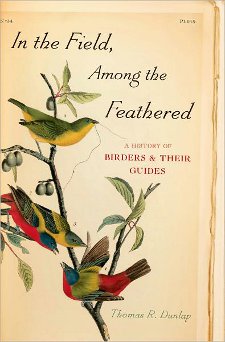Reviewed by Grant McCreary on March 12th, 2012.
North American birders have several worthy field guides to choose from, with more seemingly published every year. When I first started birding, I had the luxury of using one of the finest field guides ever created – The Sibley Guide to Birds. Moreover, just about every region of the planet now has a good and user-friendly field guide to its birds. Face it birders, we’ve got it pretty good. But it hasn’t always been this way.
In In the Field, Among the Feathered, Thomas Dunlap reveals the history of the field guide in North America, breaking it down into three stages: the pioneer period, the mature form, and the environmental age. The first begins in 1889 with Florence Merriam’s Birds through an Opera Glass, the first book on field identification for amateurs. Modern birders wouldn’t even recognize this book, and the others that followed it, as field guides. The predominantly black-and-white illustrations were not particularly helpful in identifying birds. But we would consider the text as even more out of character for field guides. The authors, mostly women, included moral and aesthetic sentiments while presenting birds “in the context of the women’s sphere of home and family”. The samples that Dunlap includes, as well as his comments on them, are fascinating, and often funny, reading. He quotes one guide as describing a Mourning Dove female as “a flabby, spineless bundle of flesh and feathers, gentle and refined in manners, but slack and incompetent in all she does”. That description may be shockingly hilarious, but I’ll be if it doesn’t ring true (ever seen a Mourning Dove nest?).
The focal point of the second stage should not be a surprise – Roger Tory Peterson’s Field Guide to the Birds. Naturally, Dunlap describes the book and what sets it apart as the first modern field guide, but also examines Peterson’s influences and the ever-increasing sophistication of birding skills.
The author maintains that the postwar period, included in this second stage of field guide development, was defined by four books: the third edition of the Peterson guide; Birds, from the Golden Nature Guides series; Olin Pettingill’s Guide to Bird Finding East of the Mississippi; and Wild America
, the story of Peterson and James Fisher’s trip through America in 1953. As you can see from this list, In the Field is not just about field guides. Dunlap also includes local ornithologies, bird-finding guides, and other books to weave together a history of birding on this continent.
It was one of these other books – Silent Spring, by Rachel Carson – that ushered in what Dunlap refers to as the environmental stage. In the early part of this period, a burgeoning environmental awareness clashed with birding as recreation. Birders were increasingly mobile, encouraged in no small part by Peterson and Fisher’s story, and increasingly competitive. As Dunlap points out, this was epitomized by Kenn Kaufman’s big year in 1973, as later told in his wonderful book, Kingbird Highway
.
Dunlap goes on to describe more modern field guides, advanced identification books, and other media from magazines to digital guides. However, as with most histories, the attention given this most recent period is frustratingly brief. Many books are discussed, but none are treated in detail, and some – like Kenn Kaufman’s Advanced Birding, surprisingly – are not mentioned at all. Likewise, digital field guides are almost completely missing.
Contrary to Spencer Schaffner in Binocular Vision: The Politics of Representation in Birdwatching Field Guides, Dunlap argues that modern bird guides, by providing a framework enabling the pastime of birding, encourage the appreciation of nature. Further, by enabling amateurs to identify birds with ever-greater skill, they allow birders to serve as citizen scientists whose observations greatly aide conservation agencies.
I did not buy Schaffner’s argument that modern field guides are blinding users to environmental concerns. But it was still surprising to me how strongly Dunlap argues the opposite: that the current stage in the development of bird books is “environmental”. As much as I’d like to think otherwise, I’m not sure that the average list-oriented modern birder is any more concerned with conservation than the users of the first field guides were. And I certainly wasn’t convinced that “competition increased consciousness about birds and about human threats to them”, as Dunlap writes. I think the truth is somewhere in between. Still, the competitive side of birding seems to get a bad rap these days, even though there is nothing inherently wrong about it, so it’s nice to see some of the benefits and usefulness of this side of birding set down in print.
Despite the subject matter, In the Field is not a very visual book. However, it does include some sample pages from books discussed therein. Most are black-and-white, but there is a small color section contrasting the treatment of warblers across a selection of books.
Recommendation
It’s easy to think of bird books as just another subgenera of books. But by advancing the study of birds, they are also encouraging their readers to engage the world around them. By this measure they are among the most important books of all. As an exploration of their history, In the Field, Among the Feathered, despite a few shortcomings, is worth reading by anyone interested in these books.






Comment